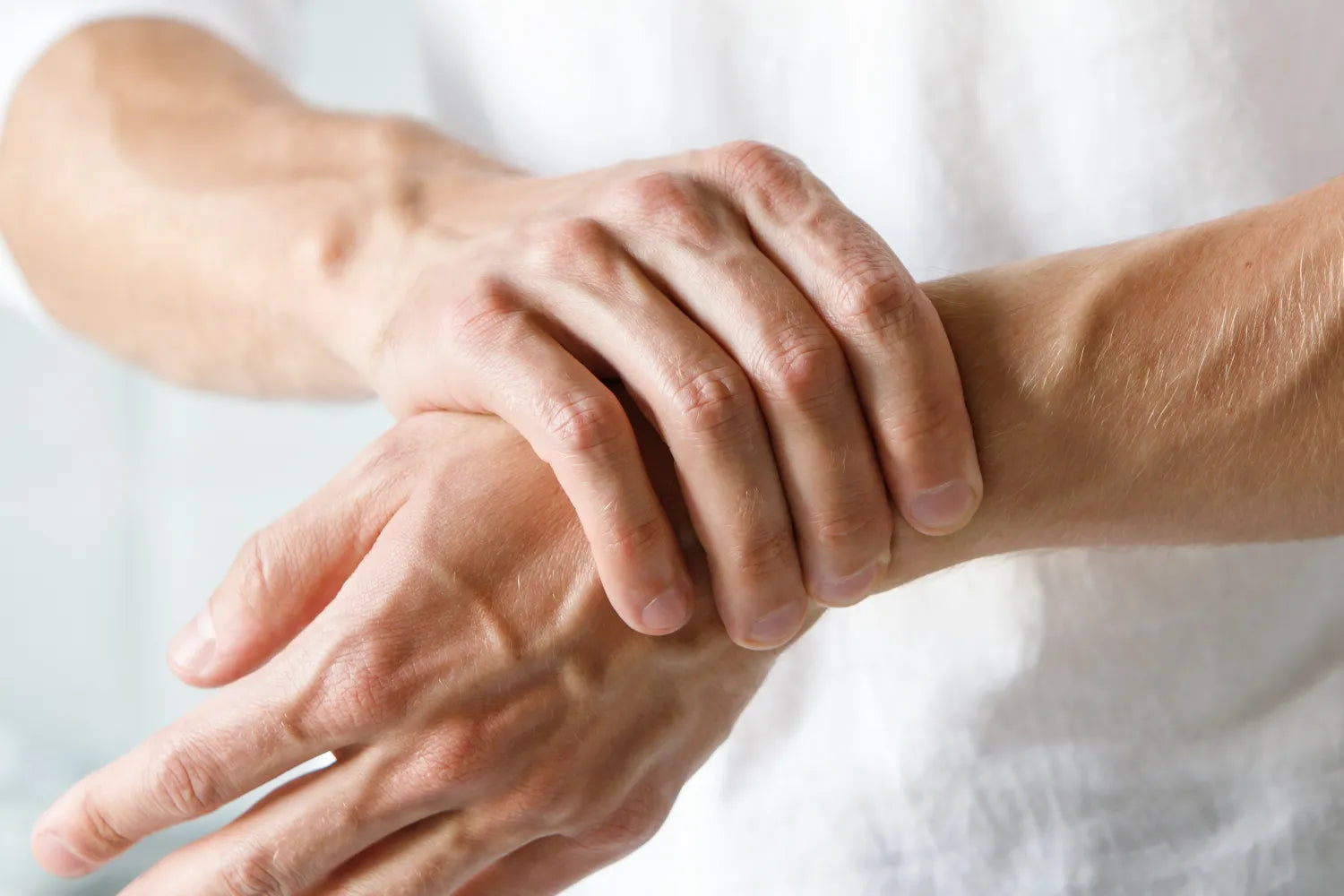7 Ways To Get Carpal Tunnel Relief
If you've ever had that pins-and-needles sensation in your hand or found yourself shaking out your fingers to get rid of numbness, you might be dealing with carpal tunnel syndrome. It's a condition that might start as a slight nuisance but can become a real hurdle in your daily life if left unchecked. After all, our hands are our primary tools for interacting with the world. We use them for almost everything, from holding our coffee cups to sending emails or enjoying our favorite meal.
If you're starting to notice symptoms of carpal tunnel syndrome, don't push them aside. It's essential to take action and find ways to lessen the discomfort and return to your normal routine. The good news is that a whole toolkit of strategies can help. Let's explore them together.
What Is Carpal Tunnel Syndrome?
Carpal tunnel syndrome is a relatively common condition that can affect the median nerve. This nerve starts at your neck, travels down your arm, and passes through the carpal tunnel, a narrow passage on the palm side of your wrist. This nerve controls the feeling in your thumb and most of your fingers, excluding the little finger.
When you have CTS, you might feel like your hand has "fallen asleep." You could experience numbness, tingling, or weakness, particularly in your thumb, index, middle, and ring fingers. These are the fingers that the median nerve controls.
The carpal tunnel is a narrow channel of small wrist bones and a tough band of tissue known as the transverse carpal ligament. When the space in this tunnel becomes tight or when the ligament thickens, it can press on the median nerve, causing the symptoms of CTS.
What Can Cause CTS?
Several risk factors can lead to the development of carpal tunnel syndrome. These include repetitive hand use, hand and wrist positioning, and certain health conditions.
Repetitive hand use involves activities where you frequently use the same hand motions, like typing or using certain tools. Hand and wrist positioning can also contribute to CTS. If your work or hobbies require your wrist to be bent for extended periods, you might be at risk. Certain medical conditions, such as rheumatoid arthritis, may also be a risk factor for CTS.
It's important to note that anyone can develop CTS, but it's most commonly seen in people who perform tasks that involve repetitive finger use. It's essential to pay attention to these risk factors and take preventative measures to maintain your hand health. If you think you may be dealing with carpal tunnel syndrome or another health condition, consult your healthcare provider for professional advice. Your doctor will be able to work with you to make a diagnosis and guide you through an appropriate treatment plan.
How To Find Relief From Carpal Tunnel Syndrome
Carpal tunnel syndrome can be quite a nuisance, but rest assured, there are several ways to find relief. From exercises to lifestyle adjustments, let's explore some potential methods and treatment options that can help you manage your symptoms and bring comfort to your hands and wrists.
1. Hand and Wrist Exercises
One effective way to alleviate discomfort from CTS is through targeted hand and wrist exercises. These exercises aim to stretch and strengthen the muscles in your hand and wrist, reducing pressure on the median nerve.
Working with a physical therapist can be particularly beneficial. They can provide you with a customized set of hand therapy exercises that cater to your specific needs. Regular sessions with a physical therapist can help manage your symptoms and may even prevent further nerve damage. So, roll up your sleeves and get ready to give your hands the workout they need!
2. Wear a Wrist Splint
Another way to find relief from wrist pain is by wearing a wrist splint. A wrist splint helps keep your hand in a neutral position, reducing pressure on the median nerve. It's particularly useful during activities that could aggravate your symptoms, like typing or driving.
Wearing a wrist splint, especially at night, can prevent your wrist from bending while you sleep. This can significantly reduce the numbness and tingling you might experience in the morning. It's like giving your hand a well-deserved break while you rest.
3. Make Ergonomic Lifestyle Adjustments
Making ergonomic adjustments to your daily life can also help ease discomfort from CTS. These adjustments aim to reduce strain on your hand and wrist during regular activities.
For instance, adjusting your workstation to ensure your wrist is not constantly bent while typing can make a big difference. The height of your chair and desk should align to allow your elbow to form a 90-degree angle when typing with your wrists straight. This position reduces the strain on your wrists.
An ergonomic mouse or keyboard, designed to promote a natural hand and wrist position, can also help prevent undue strain.
Additionally, don't forget about breaks! Regularly stepping away from your workstation, stretching, and changing your position can help maintain healthy blood flow and prevent stiffness. Remember, the goal is to keep your wrist in a neutral position as much as possible.
4. Acupuncture
Acupuncture, a technique where thin needles are inserted into specific points of the body, has been known to provide relief for some individuals with CTS. It's believed to help relieve discomfort by improving blood flow and triggering the body's natural painkillers.
While more research is needed to determine the effectiveness of acupuncture for CTS, some people have reported improved symptoms after treatment. It's always worth discussing this option with your healthcare provider to see if it might be a good fit for you.
5. Hot and Cold Therapy
Hot and cold therapy is a simple yet effective way to manage discomfort from carpal tunnel syndrome. Both forms of therapy work differently and can be used at different times to provide relief.
Hot therapy involves applying heat to the affected area, which can help boost circulation and promote healing. It's especially useful for stiff or tight muscles. You can use a warm water soak or a heated pad to apply heat to your wrist. Remember to protect your skin with a towel or cloth to prevent burns.
On the other hand, cold therapy can help numb the area and reduce swelling. It's especially useful right after an injury or if your symptoms suddenly worsen. You can use an ice pack or take an ice bath. Remember to wrap the ice pack in a cloth or towel to protect your skin.
Generally, it's a good idea to start with cold therapy for the first few days if you're experiencing sudden discomfort. After that, you can switch to hot therapy or alternate between the two.
6. Compression Therapy
Compression therapy involves wearing specially designed gear, like wrist sleeves or fingerless gloves, to promote healthy blood flow. The idea is that by applying gentle pressure to the area, you can boost circulation, which in turn helps nourish cells and remove waste products.
Compression gear can provide relief during activities that might aggravate your symptoms and can also help keep your wrist in a neutral position. Remember to ensure the gear is not too tight, as this could inhibit blood flow.
7. Try CBD for General Wrist Discomfort
If your discomfort is more general and isn’t stemming from an injury or condition like carpal tunnel syndrome, CBD, or cannabidiol, is a beneficial natural compound found in the cannabis plant.
It interacts with the body's endocannabinoid system (ECS), a complex system that supports various functions and processes, including pain perception.
Topical products, like our CBD balms, can be applied directly to the hands and wrists to provide targeted, localized support and soothing relief. When you apply CBD topically, it interacts with the endocannabinoids beneath the skin, helping ease feelings of discomfort and encourage balance.
Our cooling CBD balms with menthol provide a soothing cold therapy effect. It's like having a personal cooling system for your wrist that goes wherever you do. Plus, the balm works with the ECS to help soothe feelings of discomfort.
Remember, everyone's experience with CBD is unique, and what works for one person may not work for another. It's all about finding the right approach for you.
In the end, managing carpal tunnel syndrome is about more than just treating the symptoms. It's about making lifestyle changes and finding strategies that work for you. With patience, persistence, and the right approach, you can find the support you need.
When Should You Consider Surgery for CTS?
While non-surgical methods can be effective for managing carpal tunnel syndrome, there may come a time when you need to consider other options. If home remedies and lifestyle changes aren't relieving your discomfort, your healthcare provider may recommend different approaches, such as over-the-counter medication like ibuprofen, steroid injections, corticosteroid injections, or, in some cases, surgery.
Surgery for CTS, known as carpal tunnel release, is usually recommended when nonsurgical treatment hasn’t been sufficient or when symptoms are severe, persistent, or causing significant nerve damage. This procedure involves cutting the transverse carpal ligament to relieve pressure on the median nerve.
There are two types of carpal tunnel surgery: Open and endoscopic. Your healthcare provider can help you understand these options and guide you through the decision-making process. Remember, it's essential to discuss your symptoms, lifestyle, and personal preferences with your healthcare provider to make an informed decision when treating carpal tunnel.
What Are Tips for Preventing CTS and Supporting Wrist Health?
Preventing carpal tunnel syndrome is as important as treating it. Regular check-ups with your healthcare provider can help detect early signs of CTS and allow for prompt intervention.
Ergonomic adjustments, such as maintaining a neutral wrist position during activities and using ergonomic keyboards or mice, can also help prevent CTS. These adjustments reduce strain on your wrist and help maintain healthy blood flow.
Regular hand and wrist exercises can also help strengthen your muscles and improve flexibility. Stretching during breaks can also help maintain blood flow and prevent stiffness.
The Bottom Line
Carpal tunnel syndrome can be a challenging condition to live with, but with the right approach, you can manage your symptoms and find relief. From home remedies to lifestyle changes and even surgery, there are several ways to treat and prevent CTS.
It's essential to consult with your healthcare provider to choose the best treatment plan for you. Maintaining a healthy lifestyle and getting regular check-ups are also key for preventing CTS and other similar conditions.
As you journey towards living comfortably, consider exploring the full line of Muscle MX CBD products. Our topical CBD balms can provide targeted, localized support, working with your body's endocannabinoid system to help ease general feelings of discomfort.
Sources:
Carpal tunnel syndrome - Symptoms and causes | Mayo Clinic
4 Steps to Set Up Your Workstation | Ergonomics
Ice Packs vs. Warm Compresses For Pain | Johns Hopkins Medicine
Compression Therapy | UPMC Heart and Vascular Institute
The endocannabinoid system: Essential and mysterious | Harvard Health










































